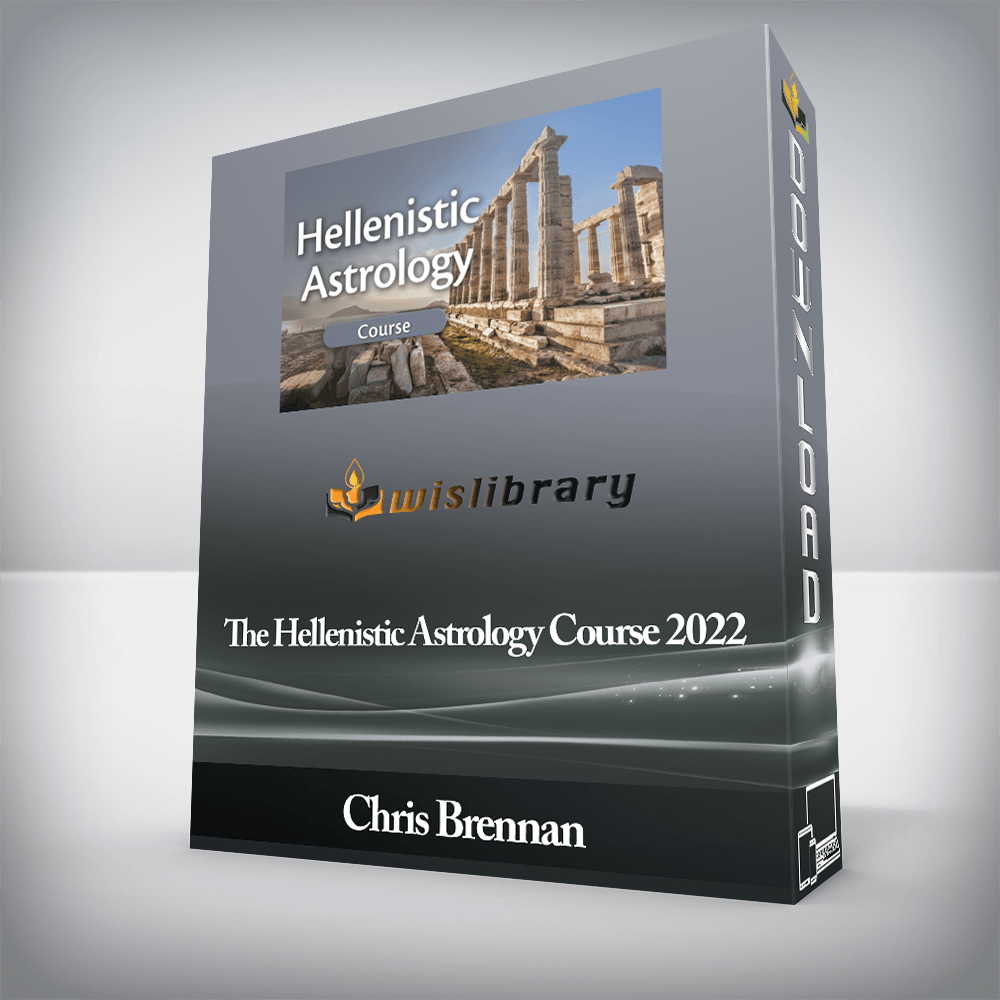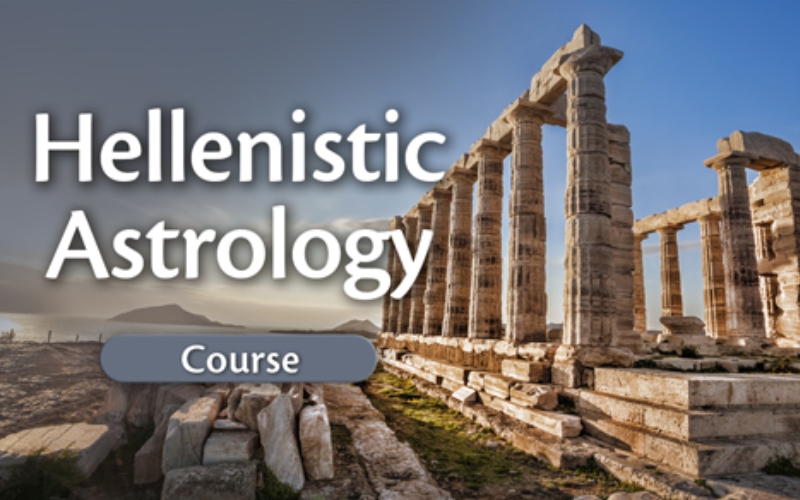Below you will find a brief synopsis of what is covered during each of the 13 parts of the course. You can also scroll down to the bottom of this page in order to see some of the different files that are available in the course, and how it is structured.
Part 1: The History of Hellenistic Astrology
The first part of the course provides a broad overview of the history of ancient astrology. In it we explore some of the historical undercurrents which fostered the development of Hellenistic astrology in Greco-Roman Egypt, and how developments in the earlier Mesopotamian and Egyptian astrological traditions led to the introduction of some of the basic technical doctrines, such as the zodiac and the twelve houses. Other topics covered include the mysterious origins of Hellenistic astrology, astrologers whose texts survived from this period, mystery schools present in the early tradition, and an overview of the ongoing efforts to recover the ancient traditions in modern times.
Part 2: The Philosophy of Hellenistic Astrology
The purpose of the second part of the course is to become familiar with the philosophical undercurrents that played a role in the development and practice of Hellenistic astrology. In particular we focus on debates surrounding the mechanism underlying astrology, as well as debates about fate and free-will, and the extent to which things were viewed as predetermined. This part of the course also features coverage of some of the major philosophical schools during this time period and their relationship with astrology, such as Platonism, Aristotelianism, Stoicism, Hermeticism, Neoplatonism, Gnosticism, and Skepticism.
Part 3: Basic Techniques and Concepts: Planets
In the third part of the course we begin a four-part series on the basic technical doctrines of Hellenistic astrology, with an overview of the ancient approach to dealing with the planets, signs, aspects, and houses. This part of the course sets a foundation for a more precise approach to predictive astrology by introducing a number of basic interpretive principles and distinctions that are either missing from or are not entirely clear in modern astrology. In the section on the planets we deal with concepts such as benefic & malefic, sect, the significations of the planets, and more.
Part 4: Basic Techniques and Concepts: Signs of the Zodiac
In the fourth part of the course we continue our series on basic concepts by focusing on the meaning of the twelve signs of the zodiac. In this part of the course we deal with concepts such as planetary rulerships, triplicity, quadruplicity, precession, and more.
Part 5: Basic Techniques and Concepts: Aspects or Configurations
In the fifth part of the course we continue our series on basic concepts by focusing on the doctrine of aspects or configurations. In this part of the course we cover concepts such as right versus left sided aspects, overcoming versus hurling rays, the quality of the different aspects, and more.
Part 6: Basic Techniques and Concepts: The Twelve Houses or Places
In the sixth part of the course we complete our series on basic concepts by focusing on the doctrine of the twelve places, which are known as “houses” in modern astrology.
In this segment we talk about the origins of the concept of houses, different forms of house division, the rationale for the meanings of the houses, planetary joys, and lots more.
Part 7: The Domicile Lord of the Hour-Marker
The seventh part of the course forms the start of a new unit, where we start taking all of the basic concepts introduced earlier and applying them to lots of example charts. In this part of the course you’ll learn how to use the ruler of the Ascendant or “Hour-Marker” in order to determine information about a person’s overall focus and life direction. This part of the course includes a review of the original conceptualization of the significations of each of the twelve houses.
Part 8: Rulers of the Twelve Places
In the eighth part of the course you will learn how to interpret the rulers of the twelve houses or “places” when they are in houses other than their own. For example, what it means when the ruler of the 7th is in the 10th, or when the ruler of the 11th is in the 9th, and so on. At this point in the course we learn how to synthesize different parts of the chart.
Part 9: Conditions of Bonification and Maltreatment
In this part of the course you will learn about a special set of considerations for determining planetary condition, known as the conditions of bonification and maltreatment. These seven conditions allow you to determine how a planet is functioning in a chart, and whether its significations are being affirmed and enhanced, or denied and corrupted. This is the final step in achieving chart synthesis.
Part 10: The Lots or “Arabic Parts”
The purpose of the tenth part of the course is to introduce the technical concept known as Lots (kleroi), which are known in modern times as “Arabic Parts.” Lots are mathematical points that are used in a chart in order to study specific topics in a person’s life, and oftentimes they can be the key to understanding things that are otherwise unclear about a person’s life. In particular we will focus on the Lot of Fortune, and discuss the rationale for its calculation, as well as its meaning and uses in chart delineations.
Part 11: Triplicity Rulers of the Sect Light
In the eleventh part of the course you will learn about the concept of rulership by trigon or triplicity, and I will show you how it is used within the context of a specific technique for determining the overall foundation of the nativity known as the triplicity rulers of the sect light. We will also introduce some of our first timing techniques, which are timing the activation of certain placements through planetary periods and ascensional times.
Part 12: Time-Lord Techniques: Annual Profections
The purpose of the twelfth part of the course is to introduce the concept of time-lord techniques, and to focus on one technique in particular known as Annual Profections.
The premise of the Hellenistic time-lord techniques is that not all placements in a given natal chart are operating at their fullest potential at any given moment in time. Instead, there are specific periods in a native’s life when certain planets or sectors in the chart become activated, thus drawing out the latent potential of those natal placements.
Annual Profections are used in order to determine which planets will be activated in a native’s life in a given year, and this allows astrologers to pinpoint the most important transits that will coincide with specific events. Profections can be used in order to determine what some of the primary themes are that will arise during the course of the year, as well as whether the year will tend to be experienced as more positive or more challenging.
Part 13: Advanced Time-lord Techniques: Zodiacal Releasing
In the thirteenth part of the course you will learn about a more advanced time-lord technique known as Zodiacal Releasing, which is one of the most impressive and powerful time-lord systems that has been recovered from the Hellenistic tradition to date.
Zodiacal Releasing divides a person’s life into chapters and paragraphs, as if the life was a book, and you were able to read the narrative of the native’s life like you would read the outline of a biography.
Each chapter in a native’s life begins with the activation of a specific planet as a time-lord, as well as the sign of the zodiac ruled by that planet.
Once all of the time-lord periods for a person’s life have been calculated, the technique can be used to identify periods of heightened importance and activity with respect to the native’s overall career and life direction, otherwise known as “peak periods.” The technique also provides information about which periods of the native’s life will tend to be experienced as the most subjectively positive or negative, career transitions, and other important life turning points.
When used in coordination with other techniques taught in the course, Zodiacal Releasing provides astrologers with a powerful method for determining information about the course of a native’s life, and becomes an indispensable tool for predicting the future.





You must be <a href="https://wislibrary.net/my-account/">logged in</a> to post a review.